Museum3D is proud to introduce Mark Kamish, our 2014 spring semester Co-Op student from the School of the Art Institute of Chicago. A recent graduate having studied in the Architecture, Interior Architecture and Design Object’s program at the school, Mark brought his talents and skills in 3D modeling and printing supporting the Hands On! Adult Tours program as well as helping mentor at the Museum’s after-school program called Teen Lab, run in partnership with After School Matters. In addition to being recently featured on camera by the School of the Art Institute, we’ve asked Mark to share his internship experience with us.
1) Tell us a little about yourself:
My name is Mark Kamish. I’m an undergrad at SAIC studying Architecture and Emerging Technologies. I have strong interests in biomimicry and robotics. Biomimicry involves is the study of natural systems to use as influence for design.
2) Describe your co-op job, any cool projects?
My current co-op internship is at the Department of Digital Information and Access at the Art Institute of Chicago. I am part of a group exploring the capabilities of 3D printing technologies as tools to engage audiences with the museum’s collections. Among the five public programs experimenting with 3D technologies, my involvement in the project has been focused in supporting two programs, the HandsOn! Tours program geared to low-vision and audiences with Alzheimer’s and also working closely on a second program dedicated to teen audiences participating in the Museum’s after-school Teen Lab program.
3) What are your responsibilities in these programs?
I have several responsibilities within the team, including: helping prepare, prototype, and produce 3D printed materials for public programs; assisting during scheduled 3D programs including but not limited to documentation, organization of program activity materials, assisting participants (such as teenage students in Teen Lab) on individual projects; assisting in 3D equipment maintenance and troubleshooting; training museum staff in the use of 3D technologies; and attending team planning meetings.
4) What are some of the interesting things you have learned or encountered?
I have learned a lot about educational programing and the power of professional communication that is required for a large collaborative project such as this. I’ve also been exposed to new career paths previously unknown or considered such as museum roles of art handlers, gallery curators, collections management, teaching, professional 3d modeling and more! However, one of the coolest things I encountered during my internship was the opportunity to work directly with Curatorial Department staff that collaborated with the project team allowing us special access to actual works of art! With guidance and supervision by art handlers of these departments, arrangements were made to take objects off view in order that I may begin the photogrammetry scan of the objects to be modeled for the HandsOn program. I especially was excited to be able to go to areas of the Museum normally not accessed by the general public such as the storage and studio areas dedicated to the preservation and storage of art works. It was like being Indiana Jones! A crusader for the protection of priceless works of art!
-
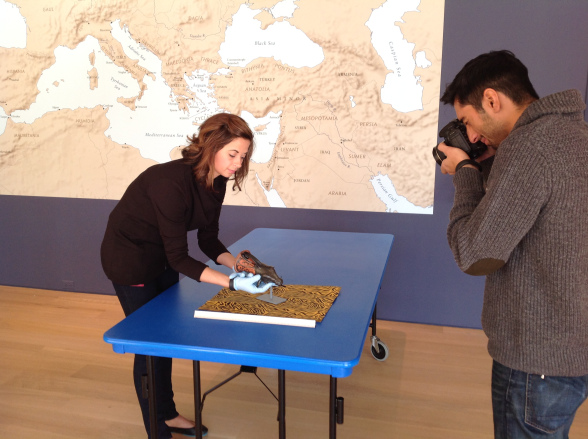
Mark completing the 3D scanning process of an ancient Greek vessel with assistance by a museum art handler. Attributed to the Painter of Leningrad 955. Rhyton (Drinking Vessel) in Shape of Sheep’s Head, 340/330 B.C. Greek; Apulia, South Italy. Terracotta, red-figure technique; 21 x 10 cm (8 1/4 x 4 in.). Bequest of Chester D. Tripp, 1986.883.
5) How has your Co-Op experience enriched your own work and education at SAIC?
This co-op experience has made me more aware of sensations involved in the tactile use of objects. Sensation in architecture is a very serious topic and, through this co-op experience, I’ve been able to see how atypical audiences experience environments and objects. This was a vital to my experience because many aspects of architecture influence sensation and perception. For people with low vision and Alzheimer’s participating in the tours, to be able to touch and feel objects brings those things from abstract ideas to tangible realities. The hope was that in touching these objects they would not only bring life back to these ancient artifacts, but also possibly bring back memories they might have. The same thing can be said about the material selection chosen in architecture. Through material, one can create new sensations or bring back old ones. I can proudly say I will be able to take these peoples’ experiences into consideration for future architectural-based projects.
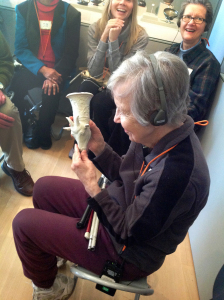
Tour participant with low vision touching the 3D printed Rhyton (Drinking Vessel) in Shape of Sheep’s Head for the first time.
6) How has this internship changed or influenced the direction of your future career?
Being able to see the skills I’ve learned in school actualized in a professional environment has opened the door towards new career paths. In my work with Teen Lab participants, it was interesting to view 3D design from a young person’s point of view and mentor them to develop a concept idea into an object realized. Not only have I gotten the experience of teaching, but I’ve also been able to see what it would be like to work in a 3D modeling industry. Up until this point, I’ve only been considering working in the architectural field, but the experiences I’ve had at The Art Institute of Chicago has opened my eyes to jobs I never even knew existed.
7) Discuss the mentoring relationship with your supervisor? How does this differ from the relationship with your professors?
Honestly, there isn’t that big of a difference. I’m generally good friends with most, if not all my professors at SAIC. So I’m not surprised that I have the same relationship with my supervisors here. Carolina, my primary supervisor, has been watching over my schedule and workflow very closely. As a professional, she understands the division between work and life that is usually unrecognized in academia. She’s very invested in my development as an individual and young professional, instead of just as an archetype. This type of recognition is extremely refreshing coming from a highly competitive architecture program where work comes before all else.
8) How important do you think co-op has been in your professional development and why?
I think it’s been pretty crucial. I’ve gotten so much exposure through this position. Recently, I was involved in an interview with AutoDesk, the creator of pivotal design programs such as AutoCad, Maya and Revit. That was very exciting! I’ve also gotten to meet several curators and department heads at the Art Institute that each contribute so significantly to the Museum’s mission and vision. If I had to sum the benefits down to two things, they would have to be networking opportunities and exposure. It also looks incredible on the resume and that does not hurt at all.
9) What tips would you give to future Co-op students?
Make sure you are applying for an internship you’ll be more than happy to go into every day. I love my job, not only for the interesting projects I get to work on, but because the environment and community have been rewarding on so many levels. Everyone I’ve met has been extremely supportive of my schoolwork and work as an intern. I’m more than happy to go in any day they call me, because they make it an enjoyable experience.
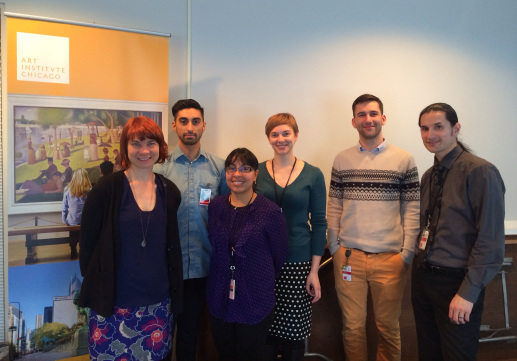
Some of the Museum staff Mark has worked with during his internship. From left to right: Museum3-D Project Director, Elizabeth Neely, Intern, Mark Kamish, Education Technology Manager and Mark’s supervisor, Carolina Kaufman, Teen and Museum Partnership Programs Coordinator, Hillary Cook, Assistant Director, Museum ISC, William Robertson, Senior Programs, Lucas Livingston
10) What was your greatest Challenge during my internship?
The biggest difficulties I encountered were the crashes within the scanning program. The scans were such high resolution; it would take what felt like an eternity to finally export them out of the program correctly. Other than this, I would have to say learning the free 3d modeling program, Blender. I’d used it once before prior to this internship, but never this intensely. My Blender know-how has definitely expanded, ha-ha!

From object to model and from 3-Dmodel to a 3-D print. Whistle with an Iguana, c. A.D. 1300. Tairona; Sierra Nevada de Santa Marta, Colombia. Ceramic and pigment; h: 4.5 cm (1 3/4 in.). Gift of Mrs. Everett McNear in memory of Everett McNear, 1986.1083.
11) Most favorable memory so far
Oh my Gosh, I’ve got so many! But by far, I truly enjoyed watching the low vision folks interact with the hands-on objects. It touched my heart to see life being brought back into those ancient objects. On a lighter note, one co-worker on the team brought in some delicious donuts; I still can’t stop talking about them!
12) Were there any surprises?
Yes! It was my first time working in a completely professional environment. I was also not aware of how much work is involved in the role of the art handler to move an object out of its museum display case. There were also so many departments, each with its own concerns and hopes for each object. The second thing that surprised me was of how large of a community the museum has. When I say ‘community,’ I mean everyone knows each other and are very helpful. The first day of work, my supervisor, Carolina, took me around the entire office and introduced me to just about every one! Occasionally, Elizabeth Pope, from the Amerindian Curatorial Department, would stop by and provide new knowledge to me about the Ocarina object, an ancient Colombian whistle I was working on. She would leave me really cool articles to read, print out related images for me to get inspired by, or just stop by to have a friendly conversation excited about the work I was doing. I really enjoyed how tight knit of a community the museum is.

Whistle with an Iguana, c. A.D. 1300. Tairona; Sierra Nevada de Santa Marta, Colombia. Ceramic and pigment; h: 4.5 cm (1 3/4 in.). Gift of Mrs. Everett McNear in memory of Everett McNear, 1986.1083.
13) You worked with teens, right? What was that like?
I’d never had the opportunity to teach before and, now that I have, I’ve considered going into an educational position. Working with the teens was incredible. They were all really lively and interested in digital fabrication and conceptual art. Every now and then one of the teens would put on their favorite song, and, before I knew it, half the class was synchronized dancing. It was really fun to learn some new dance moves and see teens comfortable in the museum. Other than that, I was really interested in how every teen approaches their project differently. I enjoyed connecting them with each of their projects, which required a different technique and approach in mentoring and guidance. I’m glad I have a wide knowledge of art styles and techniques to inspire or introduce them to things they’ve never seen. I remember one teen was really into fashion and everything she made prior was made out of recyclable material. I showed her a few of my favorite fashion shows and designers to encourage her to expand her style. I’ll never forget the twinkle in her eye and the smile of amazement. I knew that she’d just been exposed to a new world, one that she’d take great inspiration from.
14) What was the coolest thing about Teen Lab?
The coolest thing was seeing these projects come to life. I worked closely with the students on developing concepts and techniques. Everyday in teen lab, a student and I would try to print or digitally model something. My favorite parts were the hurdles you had to jump through while teaching new programs. At first, 3D modeling programs are so difficult to pick up, but once they got the hang of it, WOW, they really did some amazing work!
15) If you could have scanned anything in the museum, what would it have been?
It would probably be a sword or suit of armor from the Medieval European section. That would be incredible and not to mention fun trying to 3D print. If not those, I’d probably want to recreate models from architectural plans found in the Architecture and Design Collection.
16) How has this experience changed the way you think about museums?
Prior to this experience, I thought of museums as just institutes to exhibit work and educate society about art in general. Now that I’ve spent a little time here, I finally get to understand how everything works. I never knew a museum could be so innovative! The Art Institute is always thinking about ways to improve the visitors’ museum experience. It doesn’t want visitors to just look at art, but to experience it in a unique way unlike any other type of museum. The AIC has this incredible iPad program (LaunchPad) that allows viewers to get closer to an object’s history and view details digitally. In the application, museumgoers can zoom in on object details, as well as learn interesting trivia about the object. I think that’s incredible! And now, they have the hands-on program, which I believe is a gigantic step towards interactivity with art.
17) As you complete your internship and your final year at SAIC what are your plans after graduation?
I plan to move back to Los Angeles and apply for similar internships there. The experience I’ve had here at AIC has sparked a new love for teaching, so I am very interested in getting more experience in that field. Other than that, I will be studying for the GRE’s and prepping my portfolio for grad school applications. School may be over but the work won’t stop. 😉 Aside from work there are a few events I’m looking forward to in the summer. My sister is having her wedding, so that will be fun. I also just purchased my tickets for my very first San Diego Comic Con. Summertime is also the best time for mud runs and triathlons. So I’m really looking forward to a number of exciting events.
Museum3D would like to thank Mark who has significantly made a positive impact on the program. With Mark’s contribution to the project both creating superb 3D models for us to replicate with 3D printing technologies we are finding more ways than one to continue using his models to engage audiences further in the collection bringing new meaning and interpretation in the museum experience. We would like to extend our appreciation and gratitude to SAIC’s Co-Op Internship Office, who partnered with us to provide such wonderful and incredibly talented students. Museum3D has brought in a new Co-Op Intern for the summer semester supporting the Tween and Educator programs. We look forward to highlight their experiences on the Blog soon!
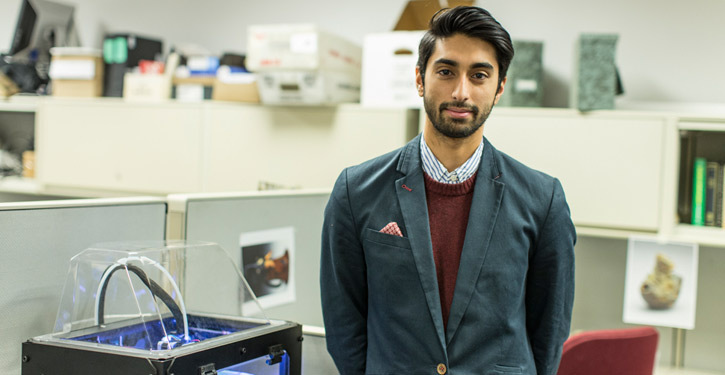

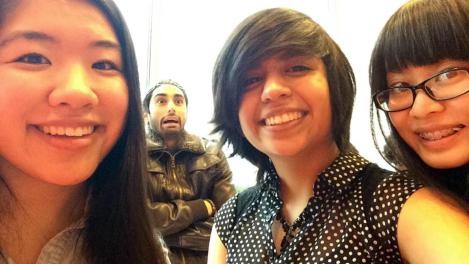
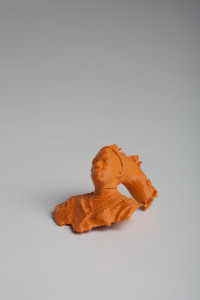
Leave a Reply